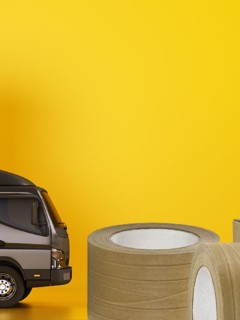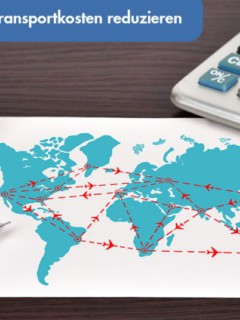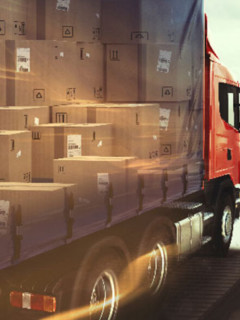According to a study by the Techniker Krankenkasse (TK), back problems are responsible for every tenth day of absence of German employees. Once plagued by back problems, each person affected is absent from work for an average of 17.5 working days per year. Almost five per cent of those who have to take sick leave due to back problems are absent for more than six weeks.
An ergonomic workplace is a must
In addition: At an unorganised packaging workplace, the risk of incorrectly addressed shipments to improper packaging or damage to the products increases. This is not only annoying for the manufacturer and the customer who is waiting for his goods, but also expensive. To avoid mistakes, optimisation in packaging and shipping should definitely be thought out by the employee:
- Does he have all the necessary tools and packaging materials within reach?
- Does the workplace offer enough space to pack consignments of different sizes properly?
- Is the workplace sufficiently illuminated and clean?
All these considerations belong to the specialist field of “ergonomics” and are not only important but even obligatory.
With the Ordinance on Industrial Safety and Health (BetrSichV), which came into force on 1 June 2015, employers are obliged to take into account the principles of ergonomics, i.e. the “humane design of work”, when designing workplaces.
See: http://www.gesetze-im-internet.de/betrsichv_2015/index.html
What is ergonomics?
Ergonomics is often equated with the adaptation of work equipment to the physical (physiological) needs of the employee, giving the impression that the primary goal is to “make the employee as comfortable as possible”. However, ergonomics is a much broader concept that serves both the employee and the employer in many ways, as the definition according to Wikipedia already shows:
“The aim of ergonomics is to optimise the working conditions, the work process, the arrangement of the objects to be gripped (workpiece, tool, semi-finished product) in terms of space and time, as well as to optimise the work equipment for a task in such a way that the work result (qualitative and economic) becomes optimal and the working people tire as little as possible or are even harmed, even if they perform the work for years.”
The advantages for the employer
The advantages for the employer are obvious:
- Less physical strain and fatigue leads to a lower risk of illness/illness
- Better prevention of accidents at work
- Higher employee satisfaction and motivation
- With regard to demographic development, this also takes into account age- and age-appropriate design
- Greater user-friendliness leads to fewer errors and increased product quality
- Less need for training due to self-explanatory, simple design of work processes
- Shorter distances and greater order of tools leads to higher work speed
Even if the redesign of workplaces initially means an investment, many companies have been able to amortise it quickly due to the overwhelming benefits. An example from the Berufsgenossenschaftliches Institut für Arbeitsschutz (BGIA) describes how the Katjes company was able to reduce the annual days of incapacity to work (AU days) due to musculoskeletal problems from 2011 to 752 by using ergonomic assembly workstations and aids. In seven years, this saved about € 1.5 million in costs for absenteeism. (More examples and details in detail on the site of the European Agency for Safety and Health at Work).
Which occupational groups are particularly often affected?
No surprise: there are occupational groups that are affected by back problems significantly more often than others. Craftsmen, employees from the construction industry and very often also geriatric nurses are exposed to great and often very one-sided strain every day.
Workers in warehousing and shipping also know about the “cross with the small of the back”: the constant repetitive movements when packing a large number of boxes can be a considerable strain on the back in the long run.
The ergonomic packing workplace
The right packing table not only contributes to more pleasant, back-friendly work. It also speeds up the work processes considerably! If cardboard, filling material, accompanying letters and adhesive tape are placed exactly where the “packer” intuitively wants to access them, much more effective work is possible. The ergonomics and the equipment of the packing table is therefore a topic worth dealing with. With three packing table systems (System 2000, System Raja as well as the System Flex) RAJA offers the packing workstation solution for every company, completely individually.
Quick test: Which packing table fits my requirements?
The answer to the following questions can be a little help on the way to the individual packaging workplace and set the first “course”. However, no quick test can replace a competent consultation!
RAJA packing table system
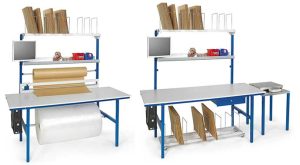
If the amount of packaging is rather low, we recommend the solid RAJA packing table system with its steel construction and 100 kg surface load capacity. It meets the highest quality standards (Made in Germany), yet the comparatively low price is achieved by limiting it to essential functions and a rather small selection of additional accessories.
Solid and inexpensive, but hardly flexible
The height of the packing table is fixed at 850mm, the add-on components are screwed on and can be adjusted in height with the help of an Allen key thanks to pre-drilled holes. However, the non-variable packing table height becomes a major disadvantage if the packing table is to be integrated into a packing line or if people of different heights work alternately at the packing table. In this case, the packing table system 2000 or even the packing table system Flex is recommended.
Packing table system Flex
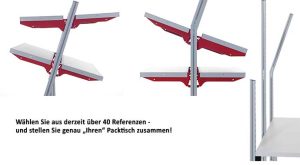
Is there an extremely high amount of packing, the packing table is used virtually around the clock, even by different people on shift duty? The Packing table system Flex offers maximum flexibility: thanks to clamping screws, the packing table is height-adjustable from 690 mm to 960 mm or even height-adjustable thanks to an additional electric motor. The table can store the individual settings of up to 4 employees, so thanks to the push of a button at the start of work, the packing table becomes your packing table. In addition, the 4-sided attachable profiles also allow the quick and tool-free attachment and rehanging of a variety of accessory components such as shelves, lights, keyboard tray, cutting device, holder for tape rollers and, and, and!
Awarded for its ergonomics
Particularly ergonomic: the components of the System Flex even accommodate the packer! The mounting profiles can also be mounted with a 20-degree inclination – all elements inserted into the mounting profile thus incline towards the user (stop edge to be ordered separately!). This facilitates access and is easy on the back and joints, not only for smaller employees. It is also extremely easy to react to different needs and different physical conditions when the add-on profiles are mounted straight: The support arms of the shelves can be easily repositioned, from 0 degrees to 20 degrees of inclination, everything is possible here.
These adjustment possibilities have also convinced the IGR e.V. (Interessengemeinschaft der Rückenschullehrer e.V.): The Flex system is the only packing table system that has been awarded the test certificate “Ergonomic Product”!
Packing table system 2000
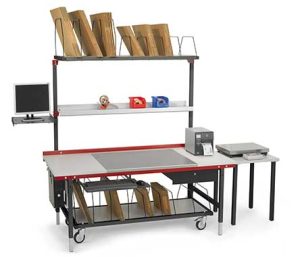
You could call it the “moderate middle”: The extensive range of accessories offers numerous expansion and retrofitting options and takes on up to 300 kg of surface load. The Packing table system 2000 offers excellent stability and is, to a certain extent, flexible. It is 2000 infinitely height-adjustable between 690 and 960 mm by means of clamping screws. Slanted shelves for more ergonomic access are also available.
Individual adaptations possible
The small limitation in comparison with the Flex packing table system: as the individual components are screwed together, individual adjustment is a little more time-consuming. Very few people will want to “screw” first before starting work. The same applies to the inclined shelves: the decision as to whether and which component is to be inclined must be made at the time of purchase. If one and the same person usually works at the packing table, the system certainly offers a sufficient degree of flexibility. However, if the packing table is to be adapted to different people or also to different work processes within one working day, the Flex packing table system is the much simpler variant.
The packing table as a workstation suitable for the disabled
By the way, even in its standard version, SYSTEM 2000 is a workplace suitable for the disabled in more than 70 percent of cases. Furthermore, SYSTEM 2000 can be tailored to the individual needs of a disabled employee – for example, a wheelchair user – by installing and attaching additional components. There is the option of installing a pneumatic lifting unit. Or simply pushing instead of lifting with the integrated roller conveyor.
And what many people certainly don’t know: Anyone who promotes the work of disabled people by providing a workplace suitable for disabled people can have this promoted themselves. The state is responsible for this: the respective integration offices. They not only advise on setting up the workplace, they also contribute to its financing – if they are involved at an early stage. To what extent is decided by the office on a case-by-case basis. But it is worth asking! Promoting and being promoted: In this particular context, this is a really sensible form of subsidy. It promotes integration – and what is perhaps even more important: it helps to realise one or two lifelong dreams.
So much flexibility comes at a price. If the question of cost plays the biggest role in the purchase decision, but a certain degree of flexibility must be guaranteed, then you should inform yourself about the Packing Table System 2000.
Is the investment in a more ergonomic packing station worthwhile?
If you are still wondering whether a complete packing workstation is a good investment, we would like to recommend the following study by the Federal Institute for Occupational Safety and Health (BAUA): National economic costs due to incapacity to work 2018. Here, the BAUA determines the average costs caused by days of incapacity to work in Germany. The loss of gross value added amounted to € 145 billion in 2018. The actual sum is likely to be even higher, as the calculation is only based on the days lost due to sick leave that were also reported to the health insurance funds. The “diseases of the musculoskeletal system and connective tissue” caused by physical overload are the most frequent cause of days lost. In relation to a single day of absence, the loss of added value amounts to approx. 180 € / day.
Without taking into account the above-mentioned positive effects of a well-organised workplace, the purchase is therefore already worthwhile if you have avoided 4 days of incapacity to work as a result. That sounds like a win-win situation for everyone involved.












